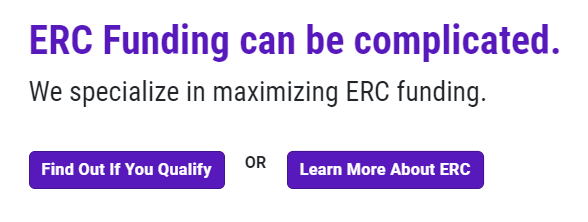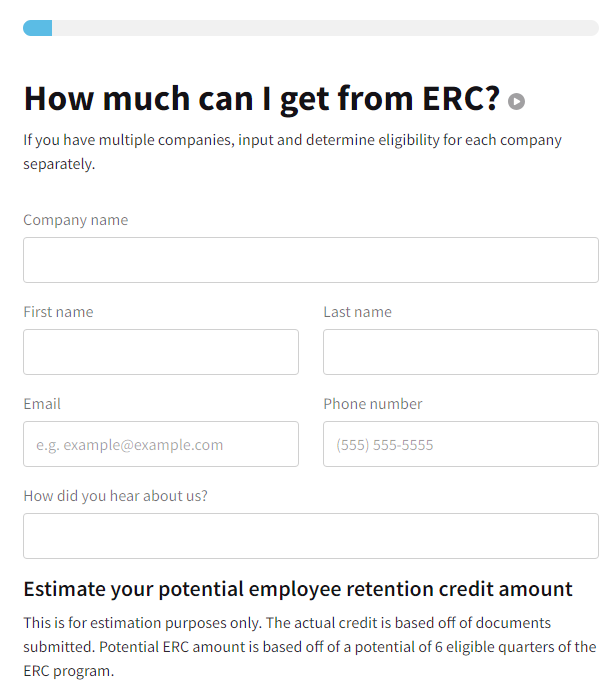Your business may benefit from the Employee Retention Tax Credit (ERTC), a financial aid program introduced to help firms navigate the stormy waters of the COVID-19 pandemic. Initially brought in by the CARES Act and later expanded, this credit was designed to encourage employers like you to keep staff on payroll, even when times were tough.
The credit doesn’t need to be repaid and could be claimed against wages paid up until December 2021 for some businesses. With eligibility rules and credit percentages changing over time, it’s crucial you’re clued up on how it all works.
Whether you’re a new business or a Recovery Startup Business seeking clarity on qualifying criteria, or simply looking to understand potential penalties, we’ve got you covered. Buckle up as we delve into everything there is to know about the ERTC 2021!

ERTC Overview
In 2021, the Employee Retention Tax Credit (ERTC) continued to serve as a lifeline for businesses impacted by COVID-19. It offers a refundable credit against qualified wages and certain health insurance costs. The eligibility criteria include forced closures or quarantines and significant declines in gross receipts.
If your business had to close temporarily or reduce operating hours due to government orders, or if you experienced more than a 20% drop in gross receipts compared to the same quarter in 2019, you may be eligible.
The American Rescue Plan Act kept the credit at 70% of qualified wages with a maximum of $7000 per employee per quarter. It’s crucial to understand this vital relief program’s rules to avoid double-dipping with other credits like the PPP loan forgiveness. Remember that expenses eligible for this must be included on the loan forgiveness application first.
To maximize your benefits from ERTC, it’s essential to understand how eligibility is determined based on reductions in business operations or gross receipts. And remember, while awaiting IRS review and potential refund issuance can take around six months, it’s worth your patience considering the financial boost you could receive from this important credit system.
Eligibility Criteria
Did you know that your business might qualify for a significant tax break if it was impacted by forced closures, quarantines, or saw more than a 20% drop in gross receipts during 2021? That’s right! The Employee Retention Tax Credit (ERTC) is designed to help businesses like yours weather the storm brought on by the COVID-19 pandemic.
To be eligible, your business must show that its operations were either fully or partially suspended due to a government order related to COVID-19 or that there was a significant decline in gross receipts. For instance, if your gross receipts for any quarter in 2021 fell below 80% of what they were for the same quarter in 2019, then you’d qualify.
What about new businesses without prior-year figures? Don’t worry – they can use their gross receipts from the quarter they started operating as reference. Moreover, Recovery Startup Businesses – those launched after February 15, 2020 with annual gross income less than $1 million – can receive up to $50,000 per quarter!
So remember: don’t miss out on this valuable credit; check your eligibility today.
Calculating the Credit
Feeling overwhelmed about figuring out your potential tax savings? Let’s break down how to calculate the value of this financial lifeline.
The Employee Retention Tax Credit (ERTC) is a refundable credit based on qualified wages paid to employees during the COVID-19 pandemic. Here’s what you need to know:
- Your ERTC is calculated as a percentage of qualified wages and health expenses, up to certain limits.
- In 2020, the credit was 50% of wages, while in 2021 it increased to 70%.
- For both years, the maximum amount per employee varies by quarter.
- Wages forgiven under PPP loans do not count towards ERTC calculations.
- For businesses with more than 100 employees (500 for those qualifying after Dec. 27, 2020), only non-working hours count towards eligible wages.
Remember that claiming this credit requires careful record keeping and strict adherence to rules about which wages are ‘qualified.’ You can’t double-dip on other credits or loan forgiveness programs when calculating the ERTC.
Although finding out your exact credit may take some time and effort, remember that every dollar saved helps keep your business thriving during these challenging times.

Claiming the Credit
Ready to cash in on those potential tax savings? Let’s dive into how you can claim this fantastic benefit that’s designed to help your business thrive during these tough times.
First, determine the total qualified wages and health insurance costs for each quarter where you’re eligible. Then, calculate the credit using 50% of wages for 2020 or 70% for 2021. You’ll report this on your quarterly employment tax return, Form 941.
To claim it retroactively, file an amended employment tax return with Form 941-X. This may seem daunting, but don’t worry! The IRS provides a handy guide to walk you through every step of the way.
Remember, though: You can’t double-dip by claiming both the Employee Retention Credit (ERC) and other credits or funding sources such as PPP loans forgiven. Also note that certain wage exclusions apply based on employee count and their service provision status.
After submitting your forms correctly and accurately, sit back and wait for your refund from the IRS – typically around six months. It might feel like a long time, but it’s well worth it when you see those savings roll in!
Recovery Startup Business
Launched your venture after February 15, 2020? You might be eligible for some serious tax benefits under the Recovery Startup Business category! The Employee Retention Tax Credit (ERTC) program introduced this brand-new category in 2021. Here’s what you need to know:
- To qualify as a Recovery Startup Business:
- Your business must have started operations after Feb. 15, 2020.
- Your annual gross receipts should not exceed $1 million.
- You don’t qualify under other ERTC categories.
The perks are impressive: qualifying businesses can pocket up to $50,000 per quarter. Plus, unlike other categories where only certain employee wages count towards the credit, startups can claim all qualified employee wages.
But remember, the Infrastructure Investment and Jobs Act revised conditions for the fourth quarter of 2021. It scrapped the requirement of forced closures or significant reduction in gross receipts for Recovery Startups.
So if you’re a new entrepreneur navigating through these challenging times, take note. This tax credit could provide a much-needed financial boost to help your business grow and thrive. Get those applications ready!
Potential Penalties
But wait, there’s more you need to consider – potential penalties for non-compliance with ERTC rules are no joke! If you’ve reduced your employment tax deposits in anticipation of the credit and later became ineligible, the IRS won’t let it slide. You must meet specific deadlines set in Notice 2021-65 to avoid a failure-to-deposit penalty.
If you received an advanced payment of the ERTC for Q4 2021 and didn’t qualify or overestimated your eligibility, you’re required to repay these advances by the due date of your applicable employment tax return. Ignoring this can result in additional penalties that could hit your business hard.
Now, if you’re a PEO or CPEO customer, there’s another layer. You’re obligated to repay any reduced employment tax deposits and advances under your PEO/CPEO accounts. And don’t forget about reporting – as a PEO client, make sure to report your retention credit on aggregate Form 941 and Schedule R.
So be vigilant about ERTC regulations – knowing them well helps keep potential penalties at bay. Don’t risk facing financial consequences that might outweigh the benefits of claiming this valuable credit.
Frequently Asked Questions
Can non-profit organizations qualify for the Employee Retention Credit?
Yes, non-profit organizations can qualify for the Employee Retention Credit. Most employers, including 501(c) organizations, are eligible. Your organization may qualify if it experienced either a business suspension due to government orders or a significant decline in gross receipts during specific periods.
Be sure to consult with your tax advisor or seek professional guidance to fully understand the eligibility requirements and how they apply specifically to your non-profit organization.
How is the Employee Retention Credit affected if my business also received funds from the Paycheck Protection Program?
If your business received Paycheck Protection Program (PPP) funds, it can still qualify for the Employee Retention Credit (ERC). However, you can’t ‘double-dip’ and claim the ERC on wages that are also accounted for in PPP loan forgiveness.
To maximize both benefits, ensure expenses eligible for PPP forgiveness are included on the loan forgiveness application first, then use any remaining qualified wages to claim the ERC.
Are there specific guidelines on how the credit received from the ERTC should be used by the business?
No, there aren’t specific guidelines on how your business should use the credit received from the Employee Retention Tax Credit (ERTC). It’s a refundable tax credit based on payroll taxes you’ve paid. So, it essentially acts as a reimbursement for wages paid to employees. The goal is to help businesses retain their employees during economic hardship caused by COVID-19. You can decide what best suits your business’ needs.
How does the Employee Retention Credit impact my business’s overall tax liability?
The Employee Retention Credit (ERC) can significantly reduce your business’s tax liability. It is a refundable credit applied against payroll taxes, meaning if the credit exceeds your payroll tax liability, you’ll receive the difference as a refund.
Additionally, it doesn’t need to be paid back and isn’t included in gross income for tax purposes. However, you can’t double-dip by claiming other credits or funding sources on wages used for the ERC.
If my business was not operational in 2019, how can we determine our eligibility for the Employee Retention Credit?
If your business wasn’t operational in 2019, you can still determine eligibility for the Employee Retention Credit. You’ll use your gross receipts from the quarter when you started as a reference point.
If you’re considered a Recovery Startup Business, meaning your business began after Feb. 15, 2020 and has annual gross receipts below $1 million, you could potentially receive up to $50,000 per quarter without needing to meet other qualifying conditions.
Conclusion
In conclusion, you’ve got a lifeline in the Employee Retention Tax Credit. It’s designed to cushion your business from the COVID-19 economic fallout.
Eligibility has been widened and includes new businesses too.
Figuring out your credit involves some math but it could be worth up to $7,000 per employee each quarter.
Don’t forget, you can claim retroactively using Form 941-X. However, stay mindful of potential penalties!
